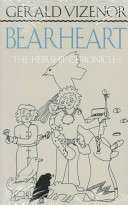Bearheart: The Heirship Chronicles

Bearheart: The Heirship Chronicles is a 1990 novel by Gerald Vizenor; it is a revised version of his 1978 debut novel Darkness in Saint Louis Bearheart. The novel is a part of the Native American Renaissance and is considered one of the first Native American novels to introduce a trickster figure into a contemporary setting, even as he drew on trickster traditions from various Native American tribes, such as Nanabozho (Anishinaabe) and Kachina (Pueblo).[1][2]
The novel follows the adventures of Proude Cedarfair as he leads a group of mixedbloods on a pilgrimage across a postapocalyptic, postindustrial United States that has run out of gas.[1][3] This novel demonstrates several of Vizenor's key concepts: his use of trickster figures; his use of mixedblood (or "crossblood") Indian characters in a non-tragic way;[3] his version of magical realism—what he calls "mythic verism";[1] and his conception of "postindian" identity;[3] and his use of parody, as in the way the novel parodies both Chaucer's The Canterbury Tales and Frederick Jackson Turner's "Frontier Thesis".[3]
References
- 1 2 3 "Gerald Vizenor", Encyclopedia of American Indian Literature, by Jennifer McClinton-Temple and Alan R. Velie, Facts on File, 2007, pp.376-378
- ↑ "Bearheart: The Heirship Chronicles", Encyclopedia of American Indian Literature, by Jennifer McClinton-Temple and Alan R. Velie, Facts on File, 2007, pp.50-51.
- 1 2 3 4 Mixedblood messages: literature, film, family, place, by Louis Owens, University of Oklahoma Press, 2001, pp.83ff.
